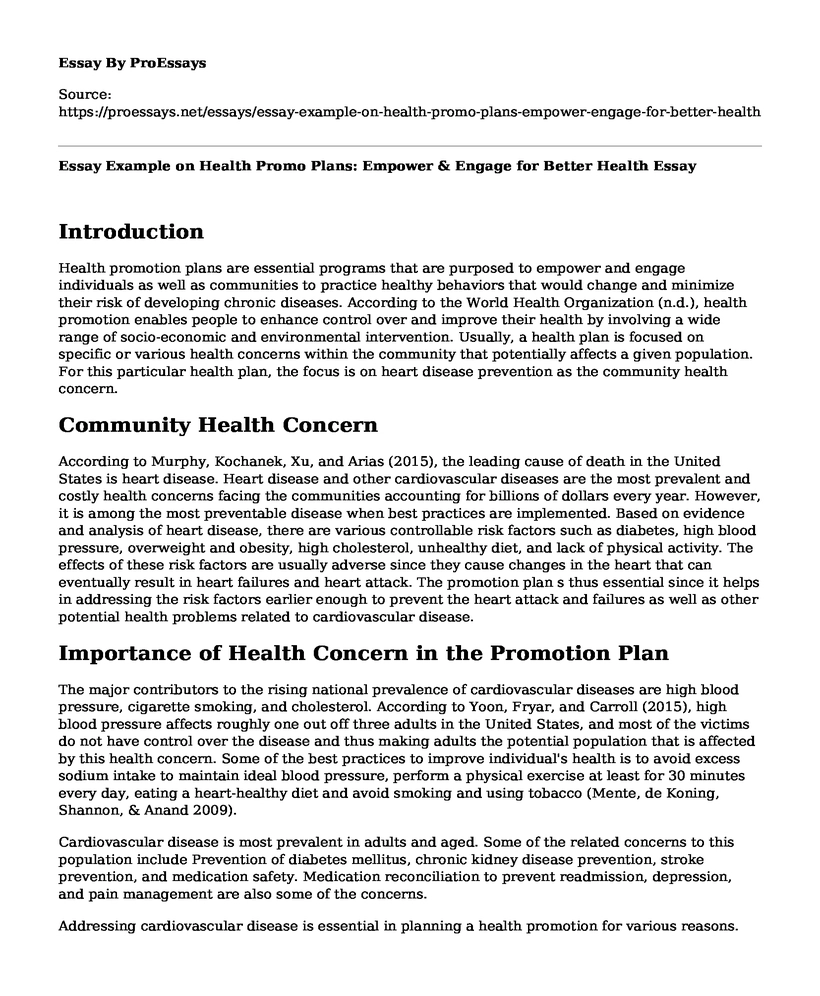Introduction
Health promotion plans are essential programs that are purposed to empower and engage individuals as well as communities to practice healthy behaviors that would change and minimize their risk of developing chronic diseases. According to the World Health Organization (n.d.), health promotion enables people to enhance control over and improve their health by involving a wide range of socio-economic and environmental intervention. Usually, a health plan is focused on specific or various health concerns within the community that potentially affects a given population. For this particular health plan, the focus is on heart disease prevention as the community health concern.
Community Health Concern
According to Murphy, Kochanek, Xu, and Arias (2015), the leading cause of death in the United States is heart disease. Heart disease and other cardiovascular diseases are the most prevalent and costly health concerns facing the communities accounting for billions of dollars every year. However, it is among the most preventable disease when best practices are implemented. Based on evidence and analysis of heart disease, there are various controllable risk factors such as diabetes, high blood pressure, overweight and obesity, high cholesterol, unhealthy diet, and lack of physical activity. The effects of these risk factors are usually adverse since they cause changes in the heart that can eventually result in heart failures and heart attack. The promotion plan s thus essential since it helps in addressing the risk factors earlier enough to prevent the heart attack and failures as well as other potential health problems related to cardiovascular disease.
Importance of Health Concern in the Promotion Plan
The major contributors to the rising national prevalence of cardiovascular diseases are high blood pressure, cigarette smoking, and cholesterol. According to Yoon, Fryar, and Carroll (2015), high blood pressure affects roughly one out off three adults in the United States, and most of the victims do not have control over the disease and thus making adults the potential population that is affected by this health concern. Some of the best practices to improve individual's health is to avoid excess sodium intake to maintain ideal blood pressure, perform a physical exercise at least for 30 minutes every day, eating a heart-healthy diet and avoid smoking and using tobacco (Mente, de Koning, Shannon, & Anand 2009).
Cardiovascular disease is most prevalent in adults and aged. Some of the related concerns to this population include Prevention of diabetes mellitus, chronic kidney disease prevention, stroke prevention, and medication safety. Medication reconciliation to prevent readmission, depression, and pain management are also some of the concerns.
Addressing cardiovascular disease is essential in planning a health promotion for various reasons. The most important reason is being the leading cause of death with the epidemiology of one out of three adults. It is a primary cause of pain and disability, especially where an individual suffers a stroke. It is also expensive to treat and reduces communities' quality of life due to the billions spent on providing healthcare services related to the disease. It is also essential to prepare a promotion plan to ensure the disparities based on geographical area, ethnicity, age, gender are addressed so that prevalence of risk factors can be controlled, timely treatment done and everybody accesses treatment.
Agreed-Upon Health Goals in Collaboration with the Community
To effectively develop a viable health promotion plan, the community is involved, especially the potential victims of the health problem by conducting an education session where the participants contribute and highlight the potential learning needs and goals. The involvement of the participants led to the development of particular goals that are measurable and achievable such as cessation of smoking and use of tobacco, daily engagement in physical exercise, and getting enough quality sleep. The most important goal is to get regular health screenings to find out cholesterol levels, blood pressure, and diabetes.
References
Mente, A., de Koning, L., Shannon, H. S., & Anand, S. S. (2009). A systematic review of the evidence supporting a causal link between dietary factors and coronary heart disease. Archives of internal medicine, 169(7), 659-669. Retrieved from https://jamanetwork.com/journals/jamainternalmedicine/article-abstract/1108492
Murphy, S. L., Kochanek, K. D., Xu, J. Q., & Arias, E. (2015). Mortality in the United States, 2014 NCHS Data Brief, no 229. Hyattsville, MD: National Center for Health Statistics.
World Health Organization (n.d.).Health promotion. Retrieved from https://www.who.int/healthpromotion/en/
Yoon, S. S., Fryar, C. D., & Carroll, M. D. (2015). Hypertension prevalence and control among adults: United States, 2011-2014 (pp. 1-8). US Department of Health and Human Services, Centers for Disease Control and Prevention, National Center for Health Statistics. Retrieved from https://pdfs.semanticscholar.org/4fd6/763d1e476e5d86792b8186f43ebd6705737a.pdf
Cite this page
Essay Example on Health Promo Plans: Empower & Engage for Better Health. (2023, Jan 18). Retrieved from https://proessays.net/essays/essay-example-on-health-promo-plans-empower-engage-for-better-health
If you are the original author of this essay and no longer wish to have it published on the ProEssays website, please click below to request its removal:
- What justice issues does Alexander raise?
- Paper Example on Fall Prevention in Nursing Homes
- Struggles Between Anti-Vaccine Parents and Pro-Vaccine Parents
- Exercise Plan for an Older Client With Coronary Heart Disease Paper Example
- PICOT: Question on Evidence Based Approach
- Pathological Diseases: Cancer and its 3 Major Gene Accelerators - Research Paper
- Rise in Diseases: A Call for Improved Healthcare Facilities - Essay Sample







